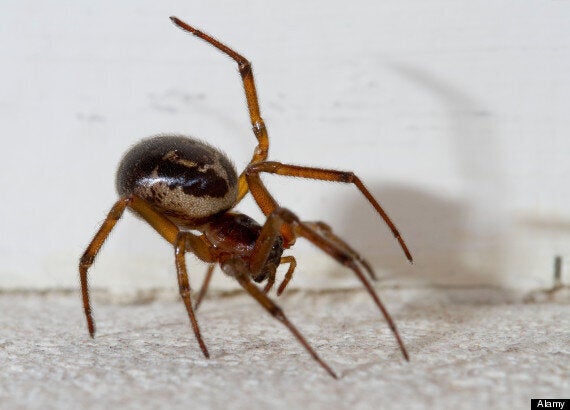A 49-year-old woman has spent five days in intensive care after a suspected bite from a false widow spider.
Alison Blackburn was woken at 4am ten days ago by a sharp pain in her stomach.
Within three hours, her leg and foot had ballooned to the point where she was unable to put her shoe on.

Alison Blackburn has been left too frightened to go upstairs in her own home after the bite
By the evening, she had a raging fever and had begun to hallucinate, prompting her partner Gary Pelatt, 50, to call an ambulance.
Blackburn was rushed to Medway Maritime Hospital in Kent where she spent five days in intensive care and had an operation to reduce the swelling from her foot.
Following her operation, the mother-of-one was told it was likely to be a false widow spider that had bitten her.
Since returning home, Blackburn has fumigated her house and washed all her clothing and bedding in an attempt to get rid of the spider.
But she says she’s still too scared to go upstairs in her home in Strood, Kent.
She said: "I'm still in shock and that spider is still around somewhere. Since coming out of hospital I'm terrified to even be in my own home.
"I can't go upstairs, I sleep on the sofa and I'm having to talk to someone about it because I'm petrified all the time.
"I can't leave the house in the day because of my leg, but I can't face being in the house either."

Six species of false widow spider have been recorded in the UK
Blackburn, who is still recovering, added: "I was hallucinating things. I thought there was water running down all of the walls.
"I was burning up and shaking and my heart murmur, which usually can't be heard, was noticed straight away by the paramedics.
"I felt so sick. I had pins and needles in my leg, it was throbbing. I was slurring my words. I had to have an operation to get rid of all the poison in my foot.
"It's been traumatic. People need to know how dangerous these spiders are - they can be lethal."
SEE ALSO:
The spiders - Steodata nobilis - are related to the black widow, but do not have the distinctive red spot on their backs. They make similar "tangle" webs, which are full of eggs, making it likely for many spiders to be in the same small area.
Unlike the black widow, the false widow spider is known to live in Britain and was first spotted in Devon in the late 1800s.
It tends to populate the coastal areas of southern England and London and it is likely the increase in its numbers is in response to climate change.
According to Stuart Hine of the Natural History Museum's (NHM) Insect Information Service, no one has ever died of a spider bite in Britain and the number of reported bites from spiders in general is minimal.
The false widow is amongst only a dozen or so of the UK's 650 species of spider that are capable of biting humans.
The NHM says reports from people believed to have been bitten by the false widow describe varying levels of burning, discomfort or numbness and associated swelling in the area surrounding the bite.
Symptoms usually disappear within one to three days, though some like Blackburn have experienced severe reactions to the arachnid's venom.